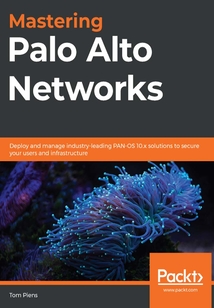舉報 

會員
Mastering Palo Alto Networks
最新章節(jié):
Other Books You May Enjoy
Tosafeguardagainstsecuritythreats,itiscrucialtoensurethatyourorganizationiseffectivelysecuredacrossnetworks,mobiledevices,andthecloud.PaloAltoNetworks’integratedplatformmakesiteasytomanagenetworkandcloudsecurityalongwithendpointprotectionandawiderangeofsecurityservices.Withthisbook,you'llunderstandPaloAltoNetworksandlearnhowtoimplementessentialtechniques,rightfromdeployingfirewallsthroughtoadvancedtroubleshooting.ThebookstartsbyshowingyouhowtosetupandconfigurethePaloAltoNetworksfirewall,helpingyoutounderstandthetechnologyandappreciatethesimple,yetpowerful,PAN-OSplatform.Onceyou'veexploredthewebinterfaceandcommand-linestructure,you'llbeabletopredictexpectedbehaviorandtroubleshootanomalieswithconfidence.You'lllearnwhyandhowtocreatestrongsecuritypoliciesanddiscoverhowthefirewallprotectsagainstencryptedthreats.Inadditiontothis,you'llgettogripswithidentifyingusersandcontrollingaccesstoyournetworkwithuserIDsandevenprioritizetrafficusingqualityofservice(QoS).Thebookwillshowyouhowtoenablespecialmodesonthefirewallforsharedenvironmentsandextendsecuritycapabilitiestosmallerlocations.Bytheendofthisnetworksecuritybook,you'llbewell-versedwithadvancedtroubleshootingtechniquesandbestpracticesrecommendedbyanexperiencedsecurityengineerandPaloAltoNetworksexpert.
目錄(107章)
倒序
- 封面
- 版權(quán)信息
- Why subscribe?
- Contributors About the author
- About the reviewers
- Packt is searching for authors like you
- Preface
- Section 1: First Steps and Basic Configuration
- Chapter 1: Understanding the Core Technologies
- Technical requirements
- Understanding the zone-based firewall
- Understanding App-ID and Content-ID
- The management and data plane
- Authenticating users with User-ID
- Summary
- Chapter 2: Setting Up a New Device
- Technical requirements
- Gaining access to the user interface
- Adding licenses and setting up dynamic updates
- Upgrading the firewall
- Hardening the management interface
- Understanding the interface types
- Section 2: Advanced Configuration and Putting the Features to Work
- Chapter 3: Building Strong Policies
- Technical requirements
- Understanding and preparing security profiles
- Understanding and building security rules
- Creating NAT rules
- Summary
- Chapter 4: Taking Control of Sessions
- Technical requirements
- Controlling the bandwidth with quality of service policies
- Leveraging SSL decryption to break open encrypted sessions
- Redirecting sessions over different paths using policy-based forwarding
- Summary
- Chapter 5: Services and Operational Modes
- Technical requirements
- Applying a DHCP client and DHCP server
- Configuring a DNS proxy
- Setting up high availability
- Enabling virtual systems
- Managing certificates
- Summary
- Chapter 6: Identifying Users and Controlling Access
- Technical requirements
- User-ID basics
- Configuring group mapping
- Setting up a captive portal
- Using an API for User-ID
- User credential detection
- Summary
- Chapter 7: Managing Firewalls through Panorama
- Technical requirements
- Setting up Panorama
- Device groups
- Setting up templates and template stacks
- Panorama management
- Summary
- Section 3: Maintenance and Troubleshooting
- Chapter 8: Upgrading Firewalls and Panorama
- Technical requirements
- Documenting the key aspects
- Preparing for the upgrade
- The upgrade process
- The rollback procedure
- Special case for upgrading older hardware
- The downgrade procedure
- Summary
- Chapter 9: Logging and Reporting
- Technical requirements
- Log storage and forwarding
- Configuring log collectors and log collector groups
- Logging Service
- External logging
- Configuring log forwarding
- Reporting
- The Application Command Center
- Filtering logs
- Summary
- z: VPN and Advanced Protection
- Technical requirements
- Setting up the VPN
- Custom applications and threats
- Zone protection and DoS protection
- Summary
- Chapter 11: Troubleshooting Common Session Issues
- Technical requirements
- Using the tools at our disposal
- Interpreting session details
- Using the troubleshooting tool
- Using maintenance mode to resolve and recover from system issues
- Summary
- Chapter 12: A Deep Dive into Troubleshooting
- Technical requirements
- Understanding global counters
- Analyzing session flows
- Debugging processes
- CLI troubleshooting commands cheat sheet
- Summary
- Chapter 13: Supporting Tools
- Technical requirements
- Integrating Palo Alto Networks with Splunk
- Monitoring with Pan(w)achrome
- Threat intelligence with MineMeld
- Exploring the API
- Summary
- Other Books You May Enjoy 更新時間:2021-06-11 18:34:28
推薦閱讀
- 深度實踐微服務(wù)測試
- HIS內(nèi)核設(shè)計之道:醫(yī)院信息系統(tǒng)規(guī)劃設(shè)計系統(tǒng)思維
- Kubernetes實戰(zhàn):構(gòu)建生產(chǎn)級應(yīng)用平臺
- Kubeflow:云計算和機器學(xué)習的橋梁
- 云計算數(shù)據(jù)中心規(guī)劃與設(shè)計
- 劍指Vue3:從入門到實踐
- Apache Solr Beginner's Guide
- 全棧性能測試修煉寶典:JMeter實戰(zhàn)(第2版)
- 交互式Web前端開發(fā)實踐
- 新編信息檢索與利用(第四版)
- 基于物聯(lián)網(wǎng)的數(shù)字社區(qū)關(guān)鍵技術(shù)及應(yīng)用
- JSP動態(tài)網(wǎng)站開發(fā)項目教程
- Linux環(huán)境編程
- Axure RP8實戰(zhàn)手冊:網(wǎng)站和APP原型制作案例精粹
- 云計算平臺構(gòu)建與5G網(wǎng)絡(luò)云化部署
- RocketMQ分布式消息中間件:核心原理與最佳實踐
- 信息安全原理與應(yīng)用
- 區(qū)塊鏈+技術(shù)與實踐
- DIV+CSS 3.0網(wǎng)頁布局實戰(zhàn)從入門到精通(全彩超值版)
- OpenStack云計算實戰(zhàn)手冊(第3版)
- TongWeb中間件實用教程
- Drupal 8 Theming with Twig
- Axure RP8網(wǎng)站與App原型設(shè)計經(jīng)典實例教程
- 基于大范圍模式的互聯(lián)網(wǎng)拓撲建模
- PHP動態(tài)網(wǎng)站開發(fā)項目教程
- 計算機網(wǎng)絡(luò)技術(shù)項目實訓(xùn)教程
- 大數(shù)據(jù)時代管理信息系統(tǒng)
- 網(wǎng)站藍圖3.0:互聯(lián)網(wǎng)產(chǎn)品(Web/APP/Apple Watch等)Axure 7原型設(shè)計寶典
- 企業(yè)級云原生架構(gòu):技術(shù)、服務(wù)與實踐
- DreamweaverCS6+HTML+CSS+DIV+JavaScript網(wǎng)站開發(fā)案例教程

